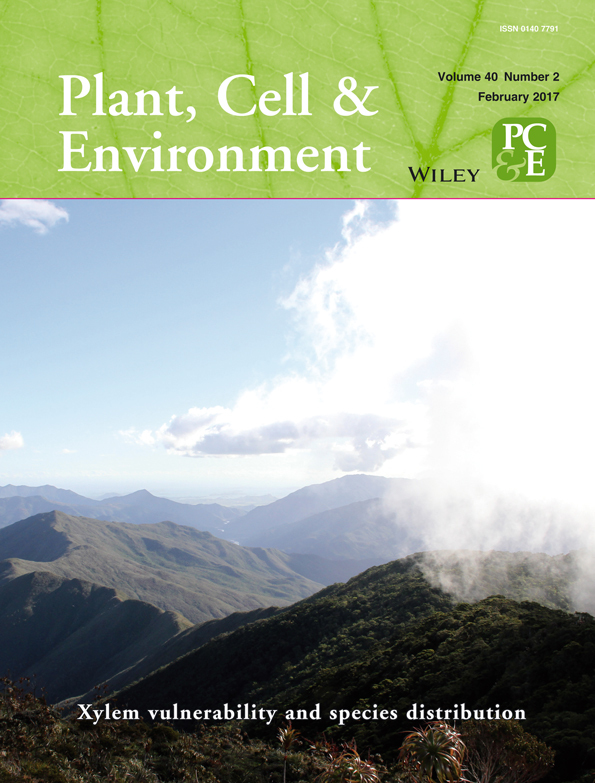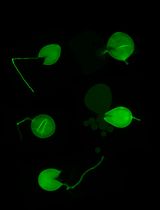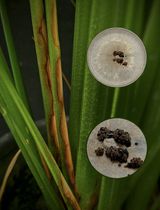- EN - English
- CN - 中文
In vivo and in vitro 31P-NMR Study of the Phosphate Transport and Polyphosphate Metabolism in Hebeloma cylindrosporum in Response to Plant Roots Signals
利用31P-NMR技术体内外研究柱孢白桦在响应植物根组织信号后的磷酸盐转运和多聚磷酸盐代谢
发布: 2018年08月20日第8卷第16期 DOI: 10.21769/BioProtoc.2973 浏览次数: 6617
评审: Marc-Antoine SaniMukesh MahajanNeelanjan Bose
Abstract
We used in vivo and in vitro phosphorus-31 nuclear magnetic resonance (31P-NMR) spectroscopy to follow the change in transport, compartmentation and metabolism of phosphate in the ectomycorrhizal fungus Hebeloma cylindrosporum in response to root signals originating from host (Pinus pinaster) or non-host (Zea mays) plants. A device was developed for the in vivo studies allowing the circulation of a continuously oxygenated mineral solution in an NMR tube containing the mycelia. The in vitro studies were performed on fungal material after several consecutive treatment steps (freezing in liquid nitrogen; crushing with perchloric acid; elimination of perchloric acid; freeze-drying; dissolution in an appropriate liquid medium).
Keywords: 31P-NMR spectroscopy (31P-核磁共振波谱法)Background
The association between mycorrhizal fungi and plants improves the P nutrition of the host-plant (Smith and Read, 2008; Plassard and Dell, 2010; Cairney, 2011; Smith et al., 2015). This positive effect has been attributed primarily to phosphate (Pi) uptake by the fungal hyphae exploring a large volume of soil beyond the depletion zone around actively absorbing roots (Smith and Read, 2008; Cairney, 2011; Smith et al., 2015) and to the secretion of extracellular phosphatases by the fungal cells (Quiquampoix and Mousain, 2005). Absorbed Pi is partly incorporated into phosphorylated metabolites, phospholipids and nucleic acids, and partly condensed into polyphosphates (PolyP) where they constitute a storage pool in the vacuoles (Ashford et al., 1994). This protocol details a device that allows the study of Pi transport in fungal cell compartments and metabolism of PolyP by 31P-NMR spectroscopy. Mycelia are incubated without plants, with host plants or with non-host plants (Torres-Aquino et al., 2017). For the in vivo studies, this perfusion system permits the circulation of an oxygenated nutrient solution in an NMR tube so that the risk of liquid leakage in the NMR spectrometer is prevented. The in vitro studies are based on the perchloric acid extraction of the fungal mycelia. This protocol could be used for other fungal or plant species.
Materials and Reagents
- 50 ml Falcon® tube (Corning, catalog number: 352098 )
- Sterile plastic Petri dish, 90 mm (Dominique DUTSCHER, Gosselin, catalog number: 688302 )
- Sterile plastic Petri dish, 35 mm (Corning, Falcon®, catalog number: 351008 )
- Nichrome wire, stainless steel, round, 22 gauge, 0.64 mm diameter (suppliers for electronic cigarettes)
- Aluminum screw cap, 40 mm with rubber liner (VWR, SPV, catalog number: 215-2690 )
- Multi-Purpose Silicone for kitchen or bathroom, 280 ml (Castorama, Rubson)
- 60 ml Luer-lock syringes (B. Braun Melsungen, Omnifix®, catalog number: 4613503F )
- TeflonTM PTFE microtube, 1.15 mm and 1.75 mm for internal (int) and external (ext) diameter (diam), respectively (Dominique DUTSCHER, PTFE, catalog number: 091932 )
- Needles 18 G 0.9 x 40 mm (Dominique DUTSCHER, BD MicrolanceTM 3, catalog number: 301300 )
- Tubing, int diam 1.14 mm (Dominique DUTSCHER, Silicone, catalog number: 4906591 )
- Tubing, int diam 3.17 mm (Dominique DUTSCHER, Silicone, catalog number: 4906600 )
- Tubing, int diam 2.79 mm (Gilson, PVC, catalog number: F117948 )
- Microtubes, 1.5 ml (Dominique DUTSCHER, Eppendorf, catalog number: 033511 )
- Straight barbed reducing connectors (Cole-Parmer, catalog number: EW-50621-95 )
- Valve Luer polycarbonate one way (Cole-Parmer, catalog number: EW-30600-01 )
- Sterile syringe filters for air, 0.2 µm, 6.4 cm diam (Labomoderne, Midisart, catalog number: RS3320 )
- Autoclavable Polypropylene bag, 3 L, non-printed (Dominique DUTSCHER, Gosselin, catalog number: 140230 )
- Tips 1,200 µl for pipet (Dominique DUTSCHER, Sartorius, catalog number: 077200B )
- Home-made syringe holder
- Home-made needle holder for aeration
- Folding skirted caps, 14.9 mm diam (Dominique DUTSCHER, Saint Gobain, catalog number: 110602 )
- Paper for sterilization (Dominique DUTSCHER, catalog number: 006950 )
- Surgical blade sterile No 21 (Dominique DUTSCHER, catalog number: 132521 )
- Borosilicate glass capillaries with filament for easy filling, 1.5 mm outer diameter, 0.86 mm internal diameter (Harvard Apparatus, catalog number: 30-0057 )
- 10 mm diameter NMR tubes for in vitro studies (Norell, catalog number: 1008-UP-8 )
- Specially homemade NMR tube for in vivo studies (see Figure 1)
- Silicone film
- Hebeloma cylindrosporum (ectomycorrhizal basidiomycete) (laboratory’s own collection, available upon request)
- Pinus pinaster
- Zea mays
- Concentrated (30%) hydrogen peroxide (H2O2) solution (Sigma-Aldrich, catalog number: 216763-500ML-M )
- Liquid nitrogen (Air Liquide)
- Calcium sulfate dihydrate (CaSO4•2H2O) (Merck, catalog number: 102161 )
- Thiamine hydrochloride –HCl (Sigma-Aldrich, catalog number: T4625-10G )
- Manganese (II) sulfate monohydrate (MnSO4•H2O) (Sigma-Aldrich, catalog number: M7899-500G )
- Zinc sulfate heptahydrate (ZnSO4•7H2O) (Sigma-Aldrich, catalog number: Z0251-100G )
- Boric acid (H3BO3) (Sigma-Aldrich, catalog number: B6768-500G )
- Copper (II) sulfate pentahydrate (CuSO4•5H2O) (Sigma-Aldrich, catalog number: C8027-500G )
- Sodium molybdate dihydrate (Na2MoO4•2H2O) (Sigma-Aldrich, catalog number: M1651-100G )
- Potassium nitrate (KNO3) (Sigma-Aldrich, catalog number: P8291-1KG )
- Sodium phosphate monobasic monohydrate (NaH2PO4•H2O) (Sigma-Aldrich, catalog number: 71504-250G-M )
- Magnesium sulfate heptahydrate (MgSO4•7H2O) (Sigma-Aldrich, catalog number: 63138-250G )
- Potassium chloride (KCl) (Sigma-Aldrich, catalog number: P9333-500G )
- Calcium chloride dihydrate (CaCl2•2H2O) (Sigma-Aldrich, catalog number: C5080-500G )
- Ferric ammonium citrate (Sigma-Aldrich, catalog number: RES20400-A702X )
- D-glucose (Sigma-Aldrich, catalog number: G8270-1KG )
- Agar-agar (Sigma-Aldrich, catalog number: A7002-500G )
- MES (2-N-morpholino-ethanesulfonic acid, 4-morpholineethanesulfonic acid monohydrate) (Sigma-Aldrich, catalog number: 69892-500G )
- Tris(hydroxymethyl)aminomethane (TRIS) (Sigma-Aldrich, catalog number: T1378-500G )
- Methylenediphosphonic acid (MDP) (Sigma-Aldrich, catalog number: M9508-5G )
- 1 N sulfuric acid solution (Merck, catalog number: 109072 )
- Perchloric acid 70% (HClO4) (Sigma-Aldrich, catalog number: 311421-250ML )
- Sodium metavanadate (NaVO3) (Sigma-Aldrich, catalog number: 590088-25G )
- Potassium bicarbonate (KHCO3) (Sigma-Aldrich, catalog number: 60339-500G )
- Ethylenediaminetetraacetic acid (EDTA) (Sigma-Aldrich, catalog number: E6758-500G )
- Potassium hydroxide 1 N (KOH) (Merck, catalog number: 105029 )
- 4-Morpholinepropanesulfonic acid (MOPS) (Sigma-Aldrich, catalog number: M1254-250G )
- Sodium azide (NaN3) (Sigma-Aldrich, catalog number: S2002-100G )
- Deuterium oxide (D2O) (Sigma-Aldrich, catalog number: 151882-100G )
- Trace elements (see Recipes)
- Mineral salt base solutions (see Recipes)
- Thiamine solution (see Recipes)
- N6 complete liquid solution (see Recipes)
- Solid N6 complete liquid solution (see Recipes)
- Interaction medium (IM) (see Recipes)
Equipment
- Sample bottles,120 ml (VWR, SPV, catalog number: SPVAGO2246 )
- Glass bottles, 1,000 ml, ISO borosilicate, graduated (Dominique DUTSCHER, catalog number: 046415 )
- Glass bottles, 2,000 ml, ISO borosilicate, graduated (Dominique DUTSCHER, catalog number: 046416 )
- Glass cylinder (diameter 7 mm)
- Graduated borosilicate glass beaker 1,000 ml (Dominique DUTSCHER, catalog number: 068942 )
- Polypropylene economical beaker 3,000 with moulded graduations (Dominique DUTSCHER, catalog number: 391134 )
- Two pairs of stainless steel straight tweezers Wironit, Brucelles type, 130 mm (Dominique DUTSCHER, catalog number: 491037 )
- A scalpel handle for blade 20 to 25 (Dominique DUTSCHER, catalog number: 3740004 )
- A standalone burner (Dominique DUTSCHER, catalog number: 071109 )
- Butane gas cartridge for the burner (Dominique DUTSCHER, catalog number: 060415 )
- A nail, a hammer, scissors and cutting pliers
- Incubator with controlled temperature set at 25 °C
- Autoclave
- Laminar flow cabinet
- Cork-borer, 7.5 mm diameter (Dominique DUTSCHER, catalog number: 942783 )
- High pressure O2 gas cylinder (Air products)
- Centrifuge 5804 R, refrigerated, without rotor (Eppendorf, model: 5804 R , catalog number: 5805000017)
- Rotor F-34-6-38, for 6 × 85 ml tubes, incl. rotor lid (Eppendorf, catalog number: 5804727002 )
- Adapter for 50 ml Falcon tubes (Dominique DUTSCHER, catalog number: 033252 )
- Peristaltic pump (Gilson Minipuls3)
- Varian UNITY INOVA 500 MHz NMR spectrometer equipped with a 10 mm broad band probe operating at 202.4 MHz for 31P
Software
- Microsoft Excel for calculations
- Statistica 7.1 (StatSoft Inc., Tulsa, OK, USA) for statistical analysis
- VnmrJ and ACDlabs for processing the 31P-NMR spectra
Procedure
文章信息
版权信息
© 2018 The Authors; exclusive licensee Bio-protocol LLC.
如何引用
Le Guerneve, C., Becquer, A., Torres-Aquino, M., Amenc, L. K., Trives-Segura, C., Staunton, S., Plassard, C. and Quiquampoix, H. (2018). In vivo and in vitro 31P-NMR Study of the Phosphate Transport and Polyphosphate Metabolism in Hebeloma cylindrosporum in Response to Plant Roots Signals. Bio-protocol 8(16): e2973. DOI: 10.21769/BioProtoc.2973.
分类
微生物学 > 微生物-宿主相互作用 > 真菌
生物物理学 > 核磁共振波谱法 > 体内NMR光谱法
细胞生物学 > 细胞新陈代谢 > 其它化合物
您对这篇实验方法有问题吗?
在此处发布您的问题,我们将邀请本文作者来回答。同时,我们会将您的问题发布到Bio-protocol Exchange,以便寻求社区成员的帮助。
Share
Bluesky
X
Copy link














